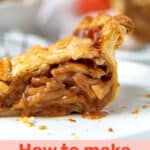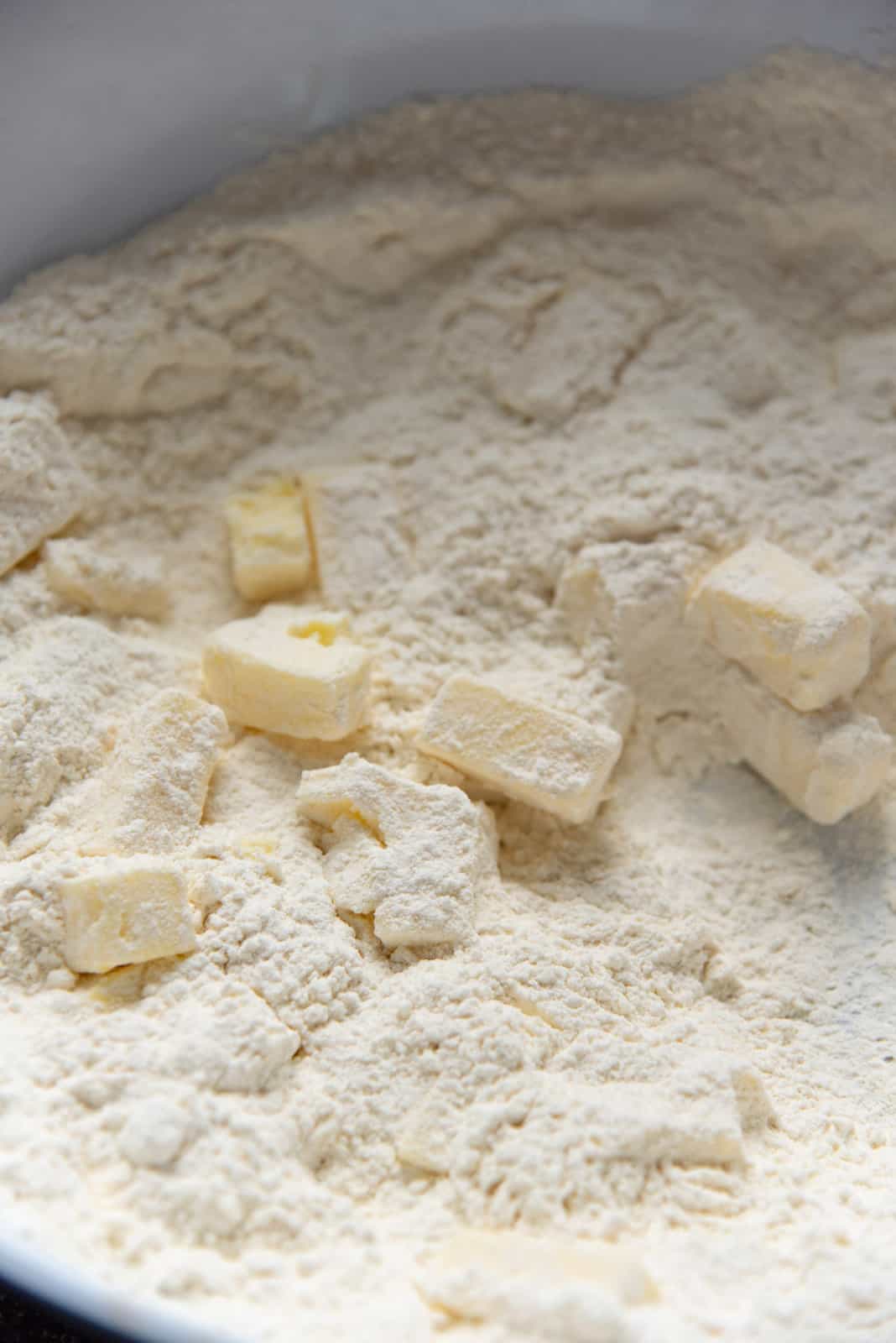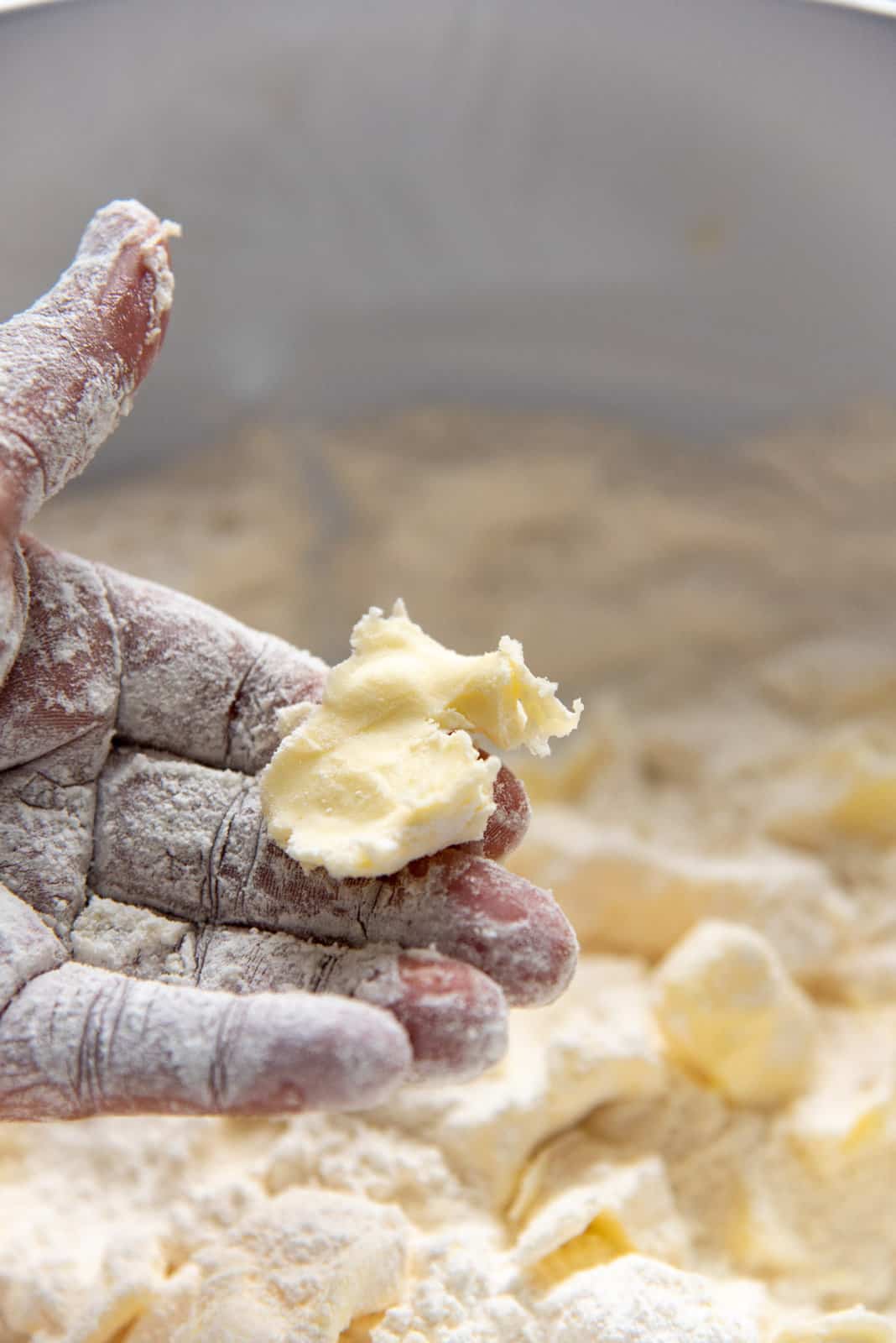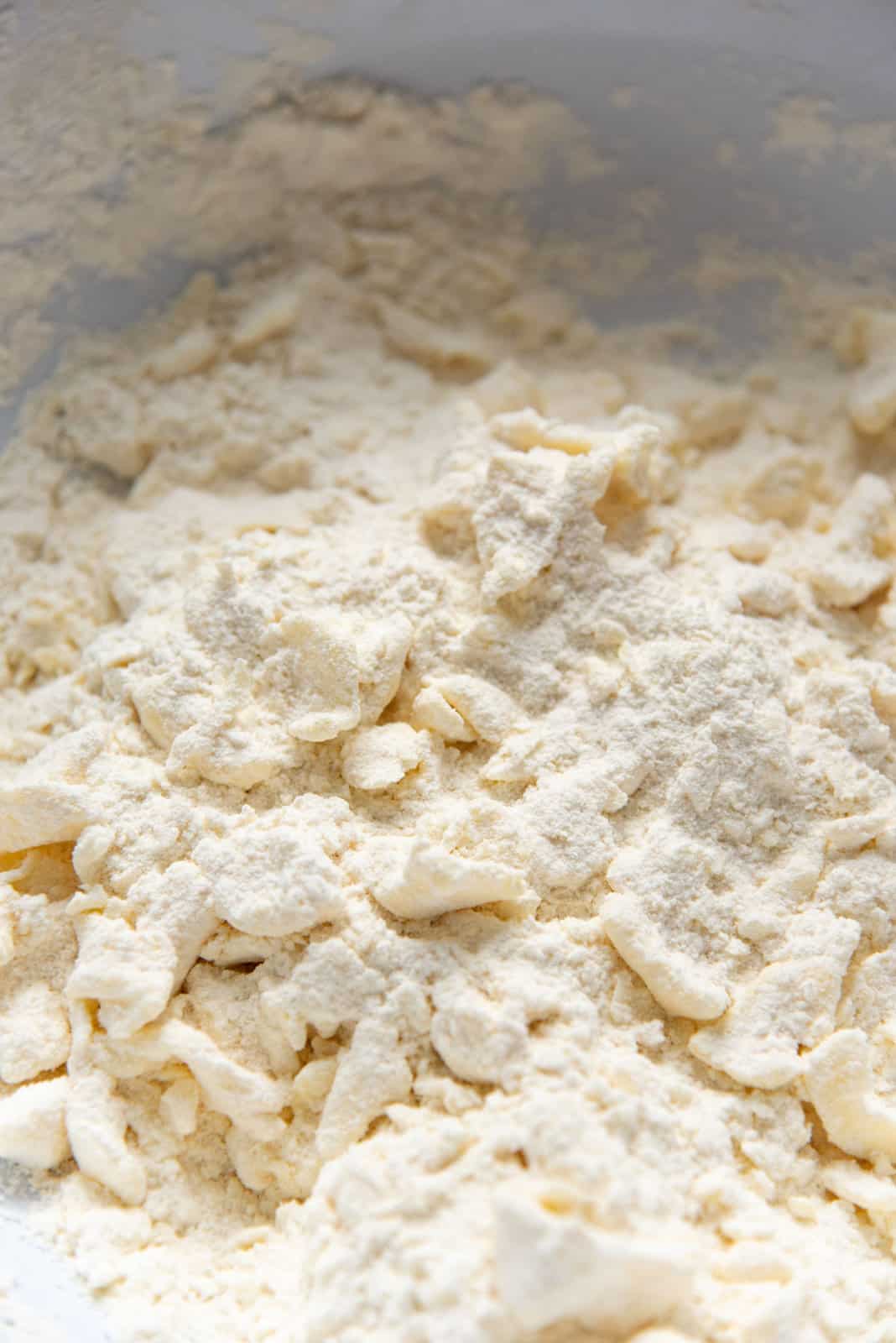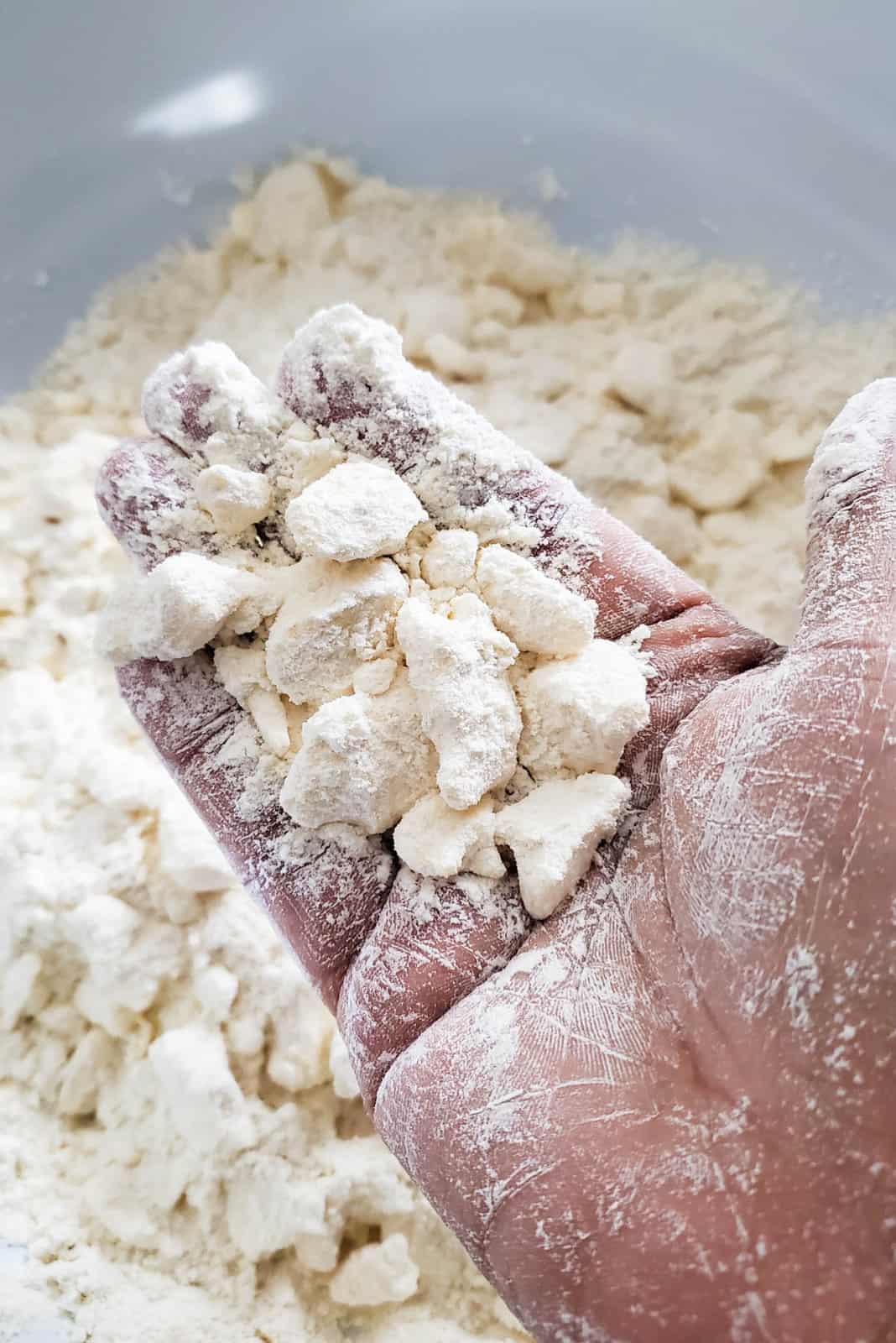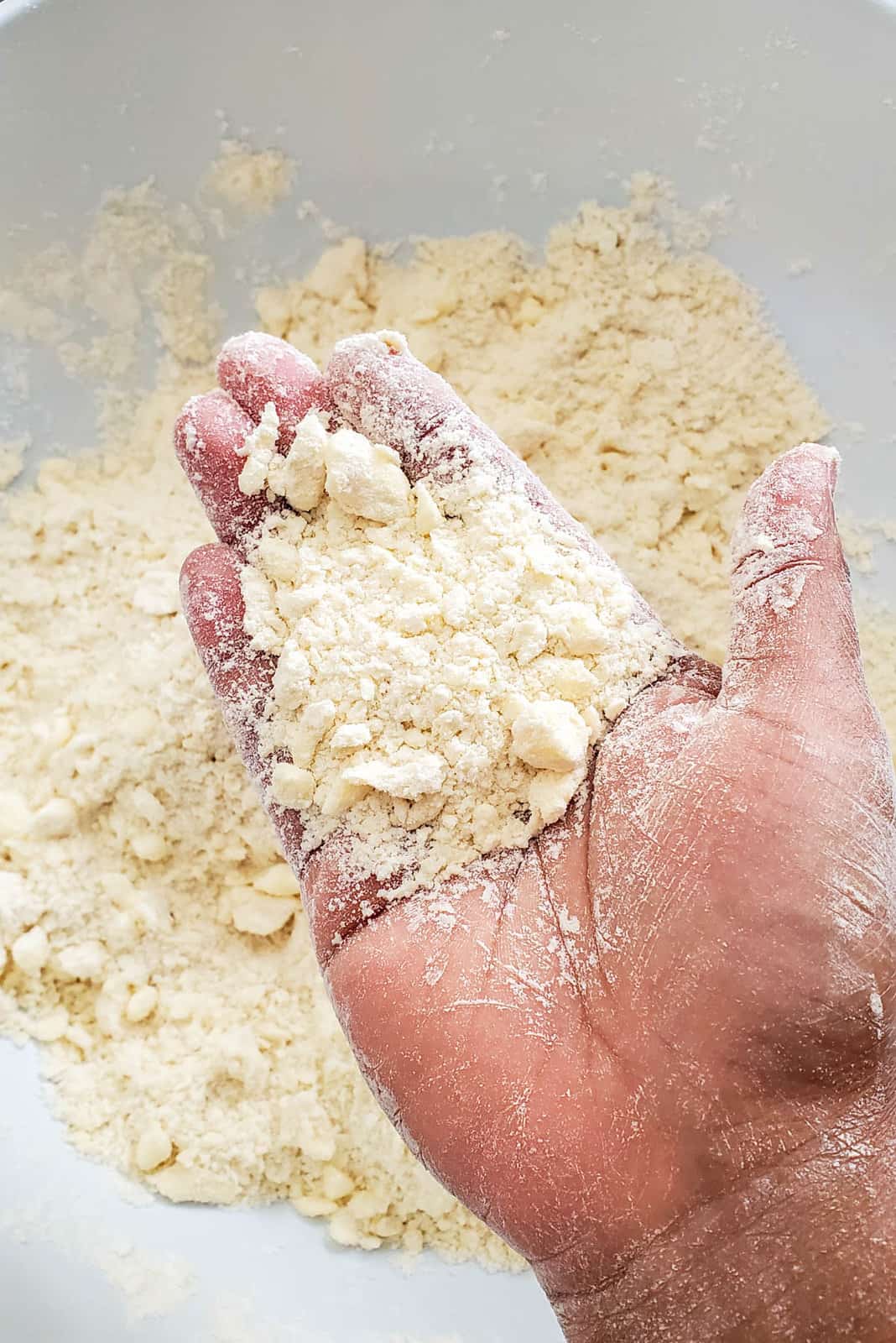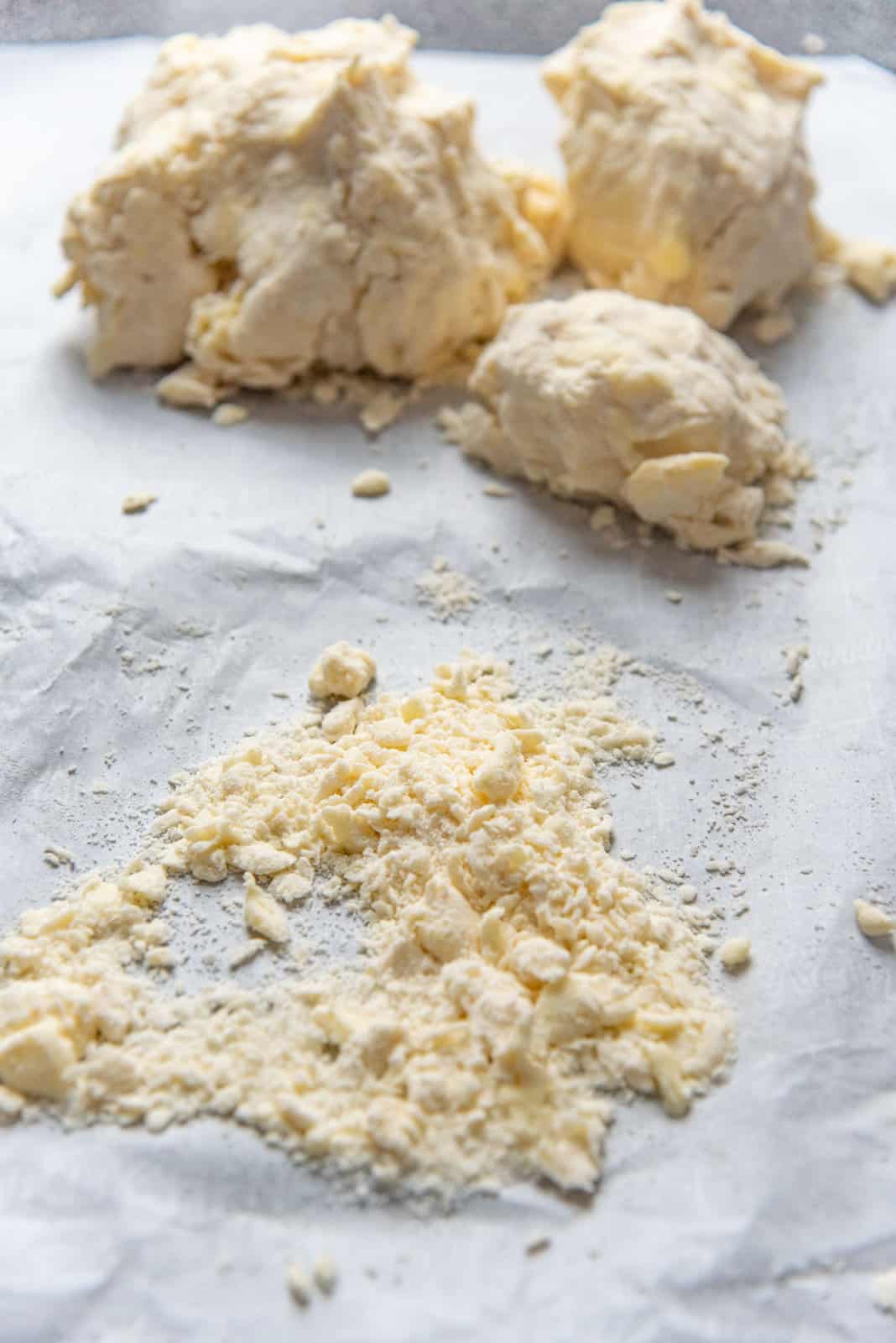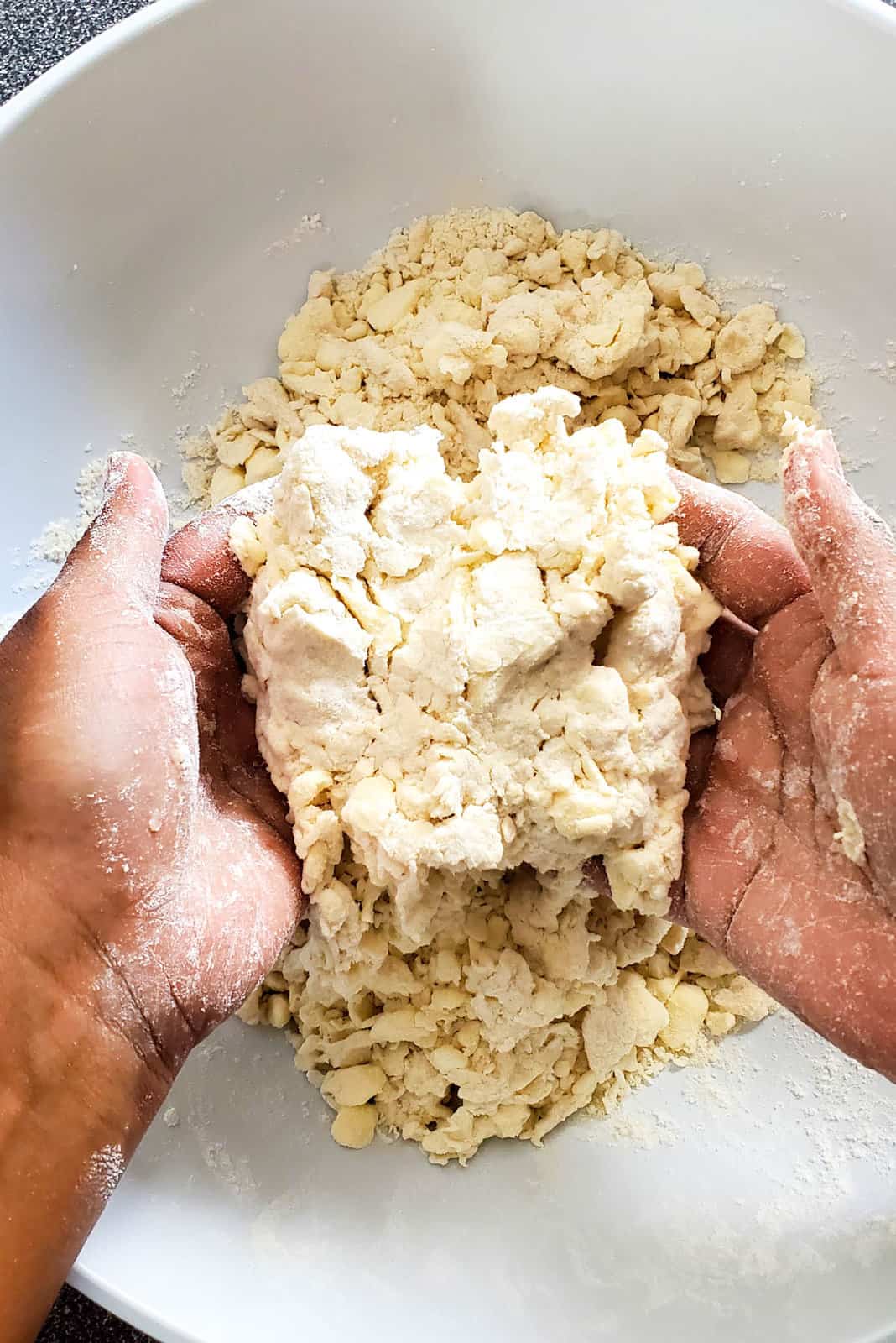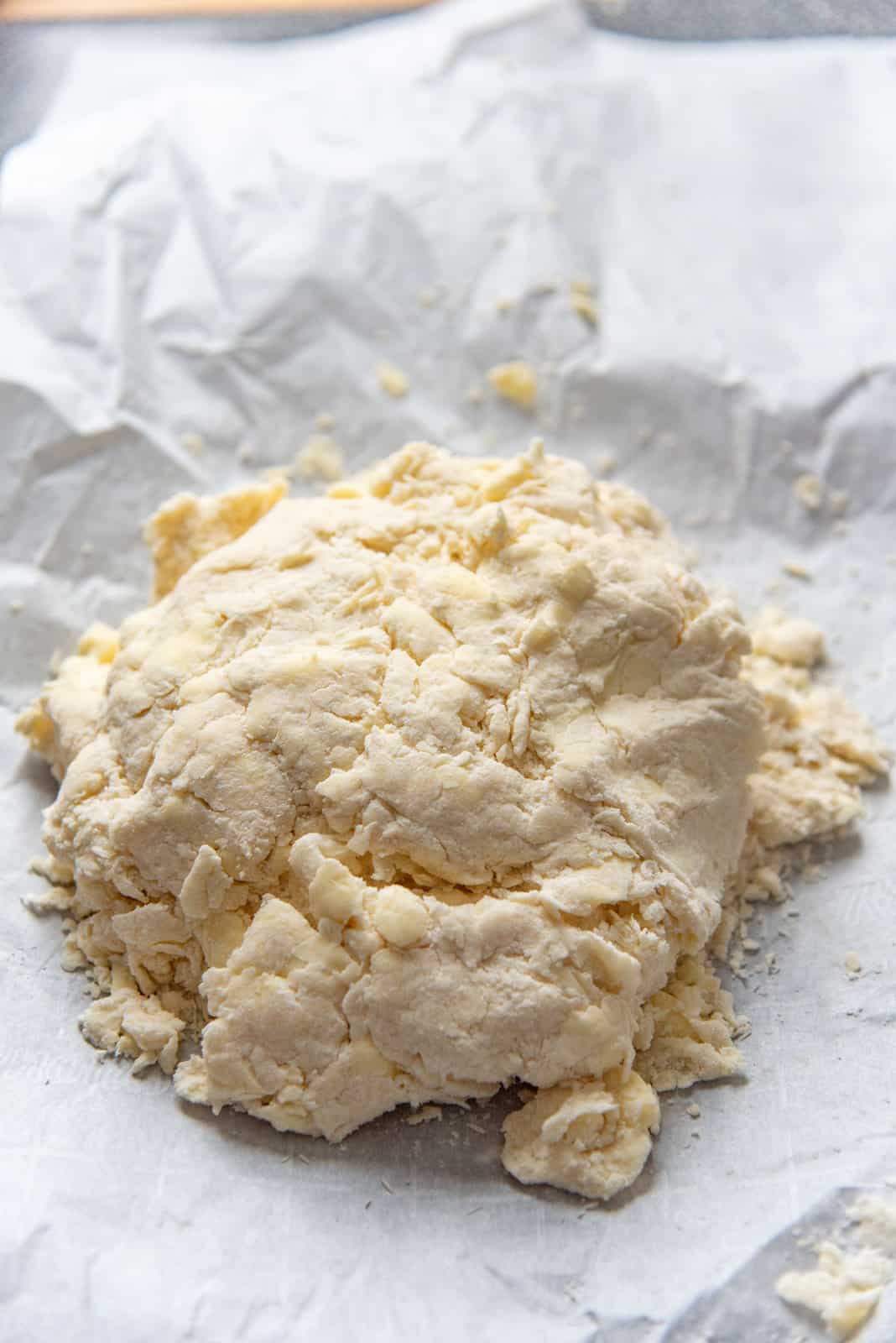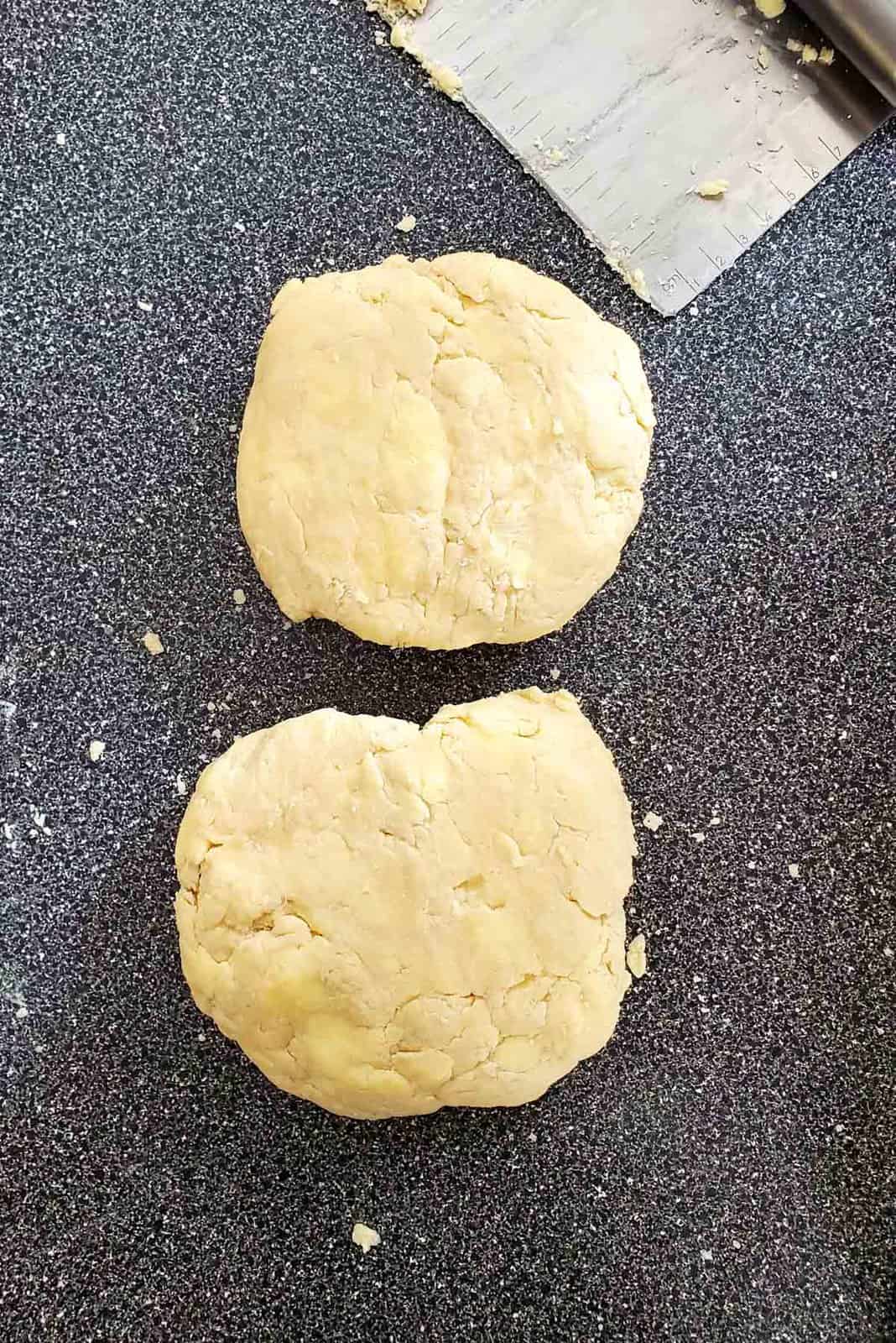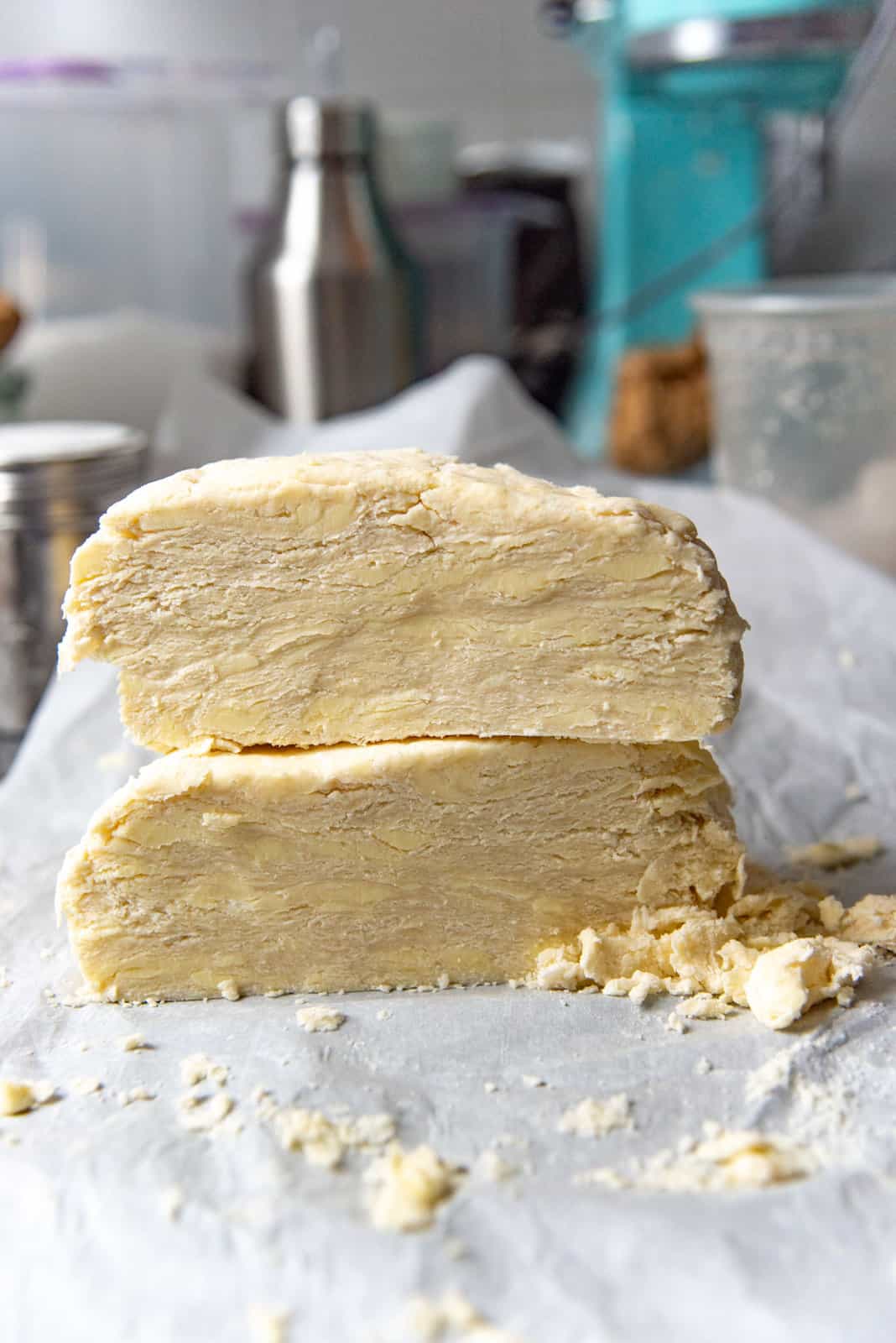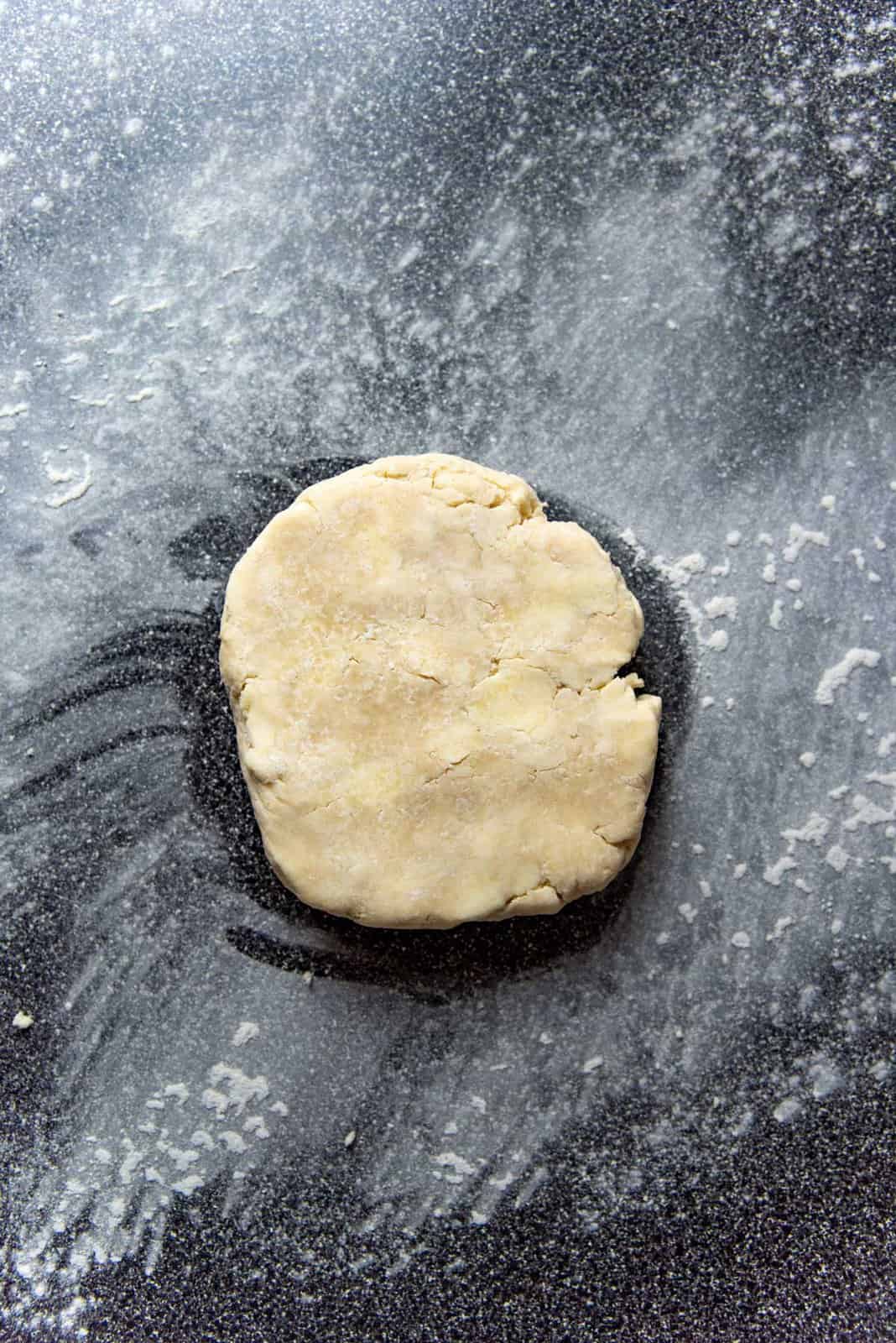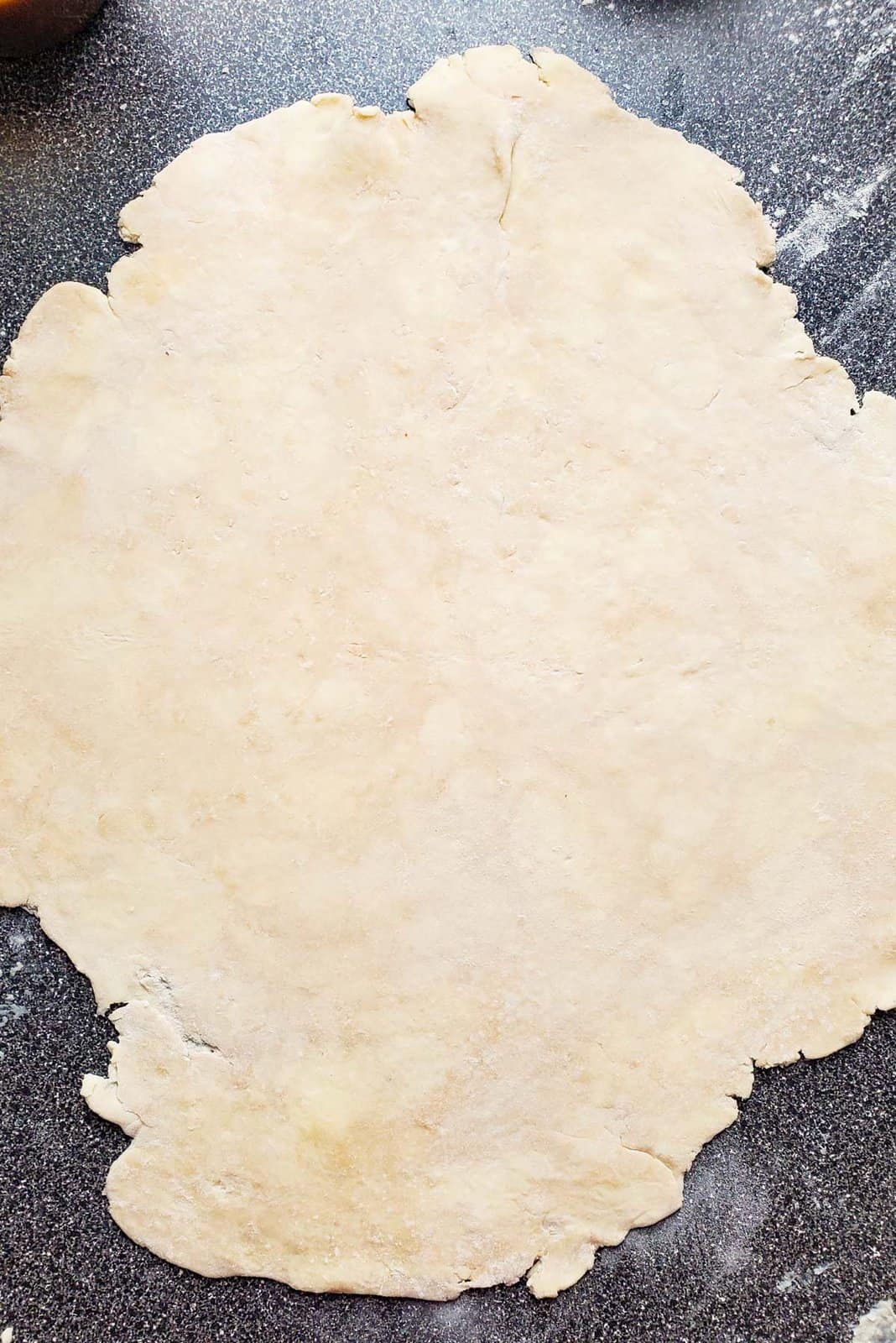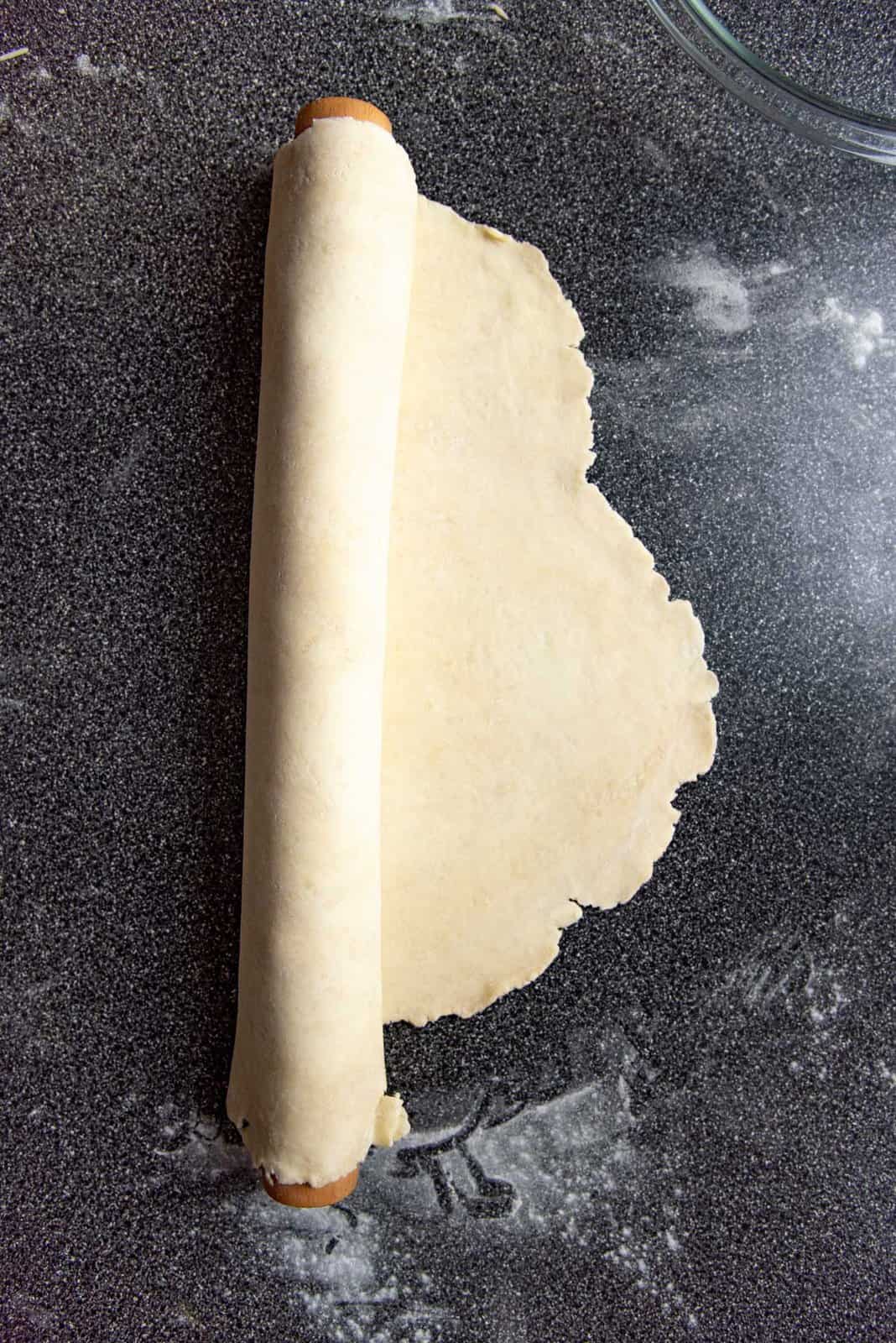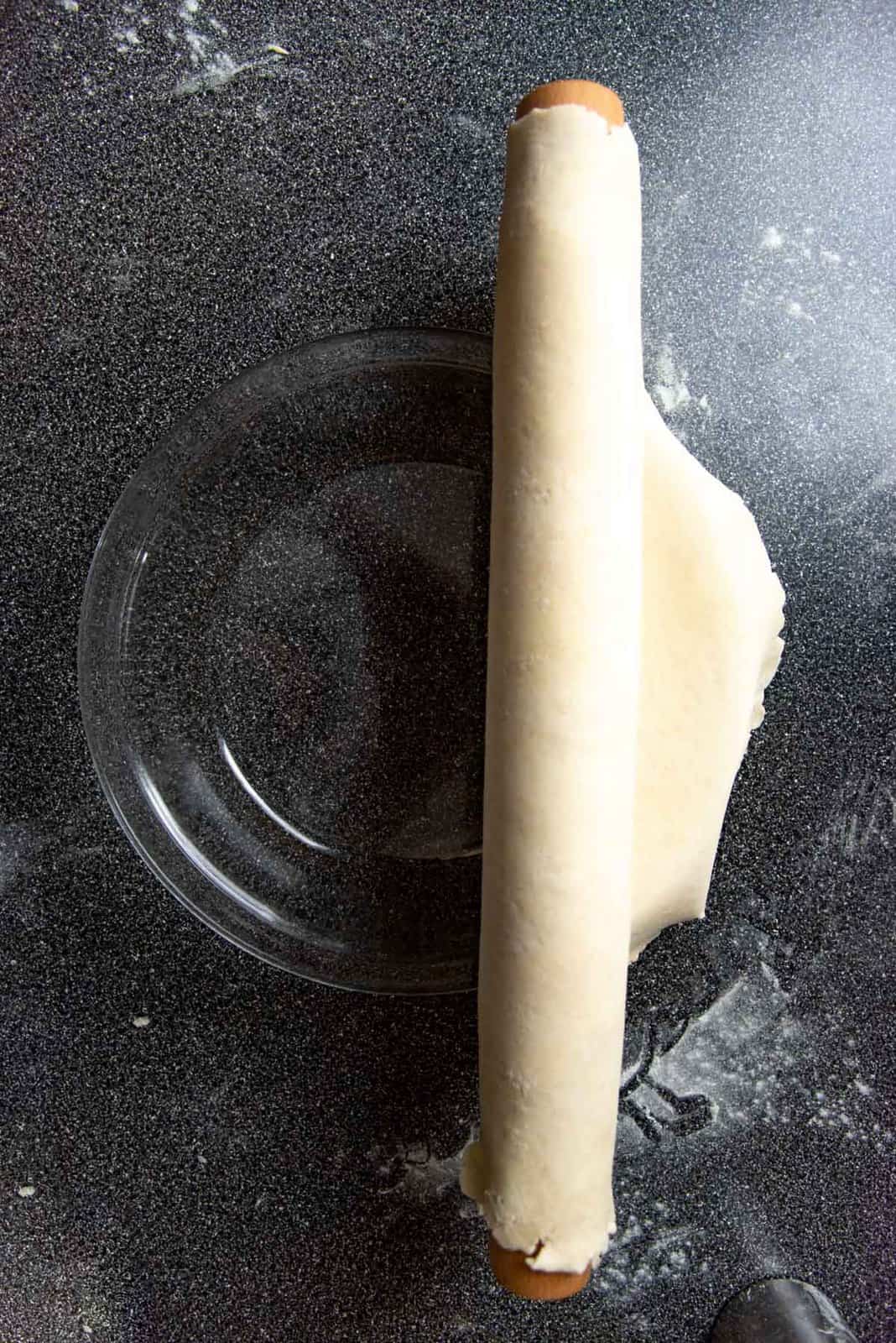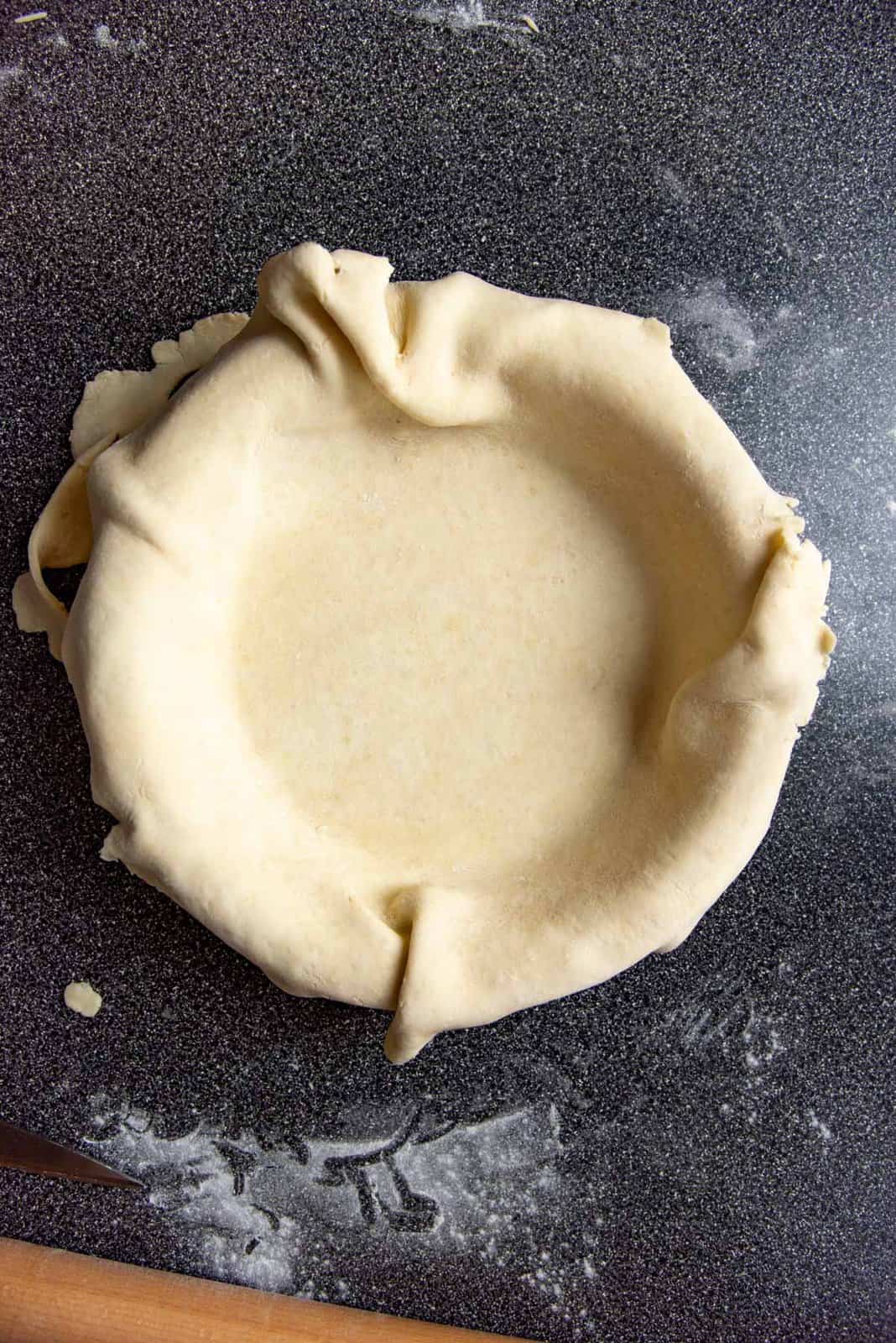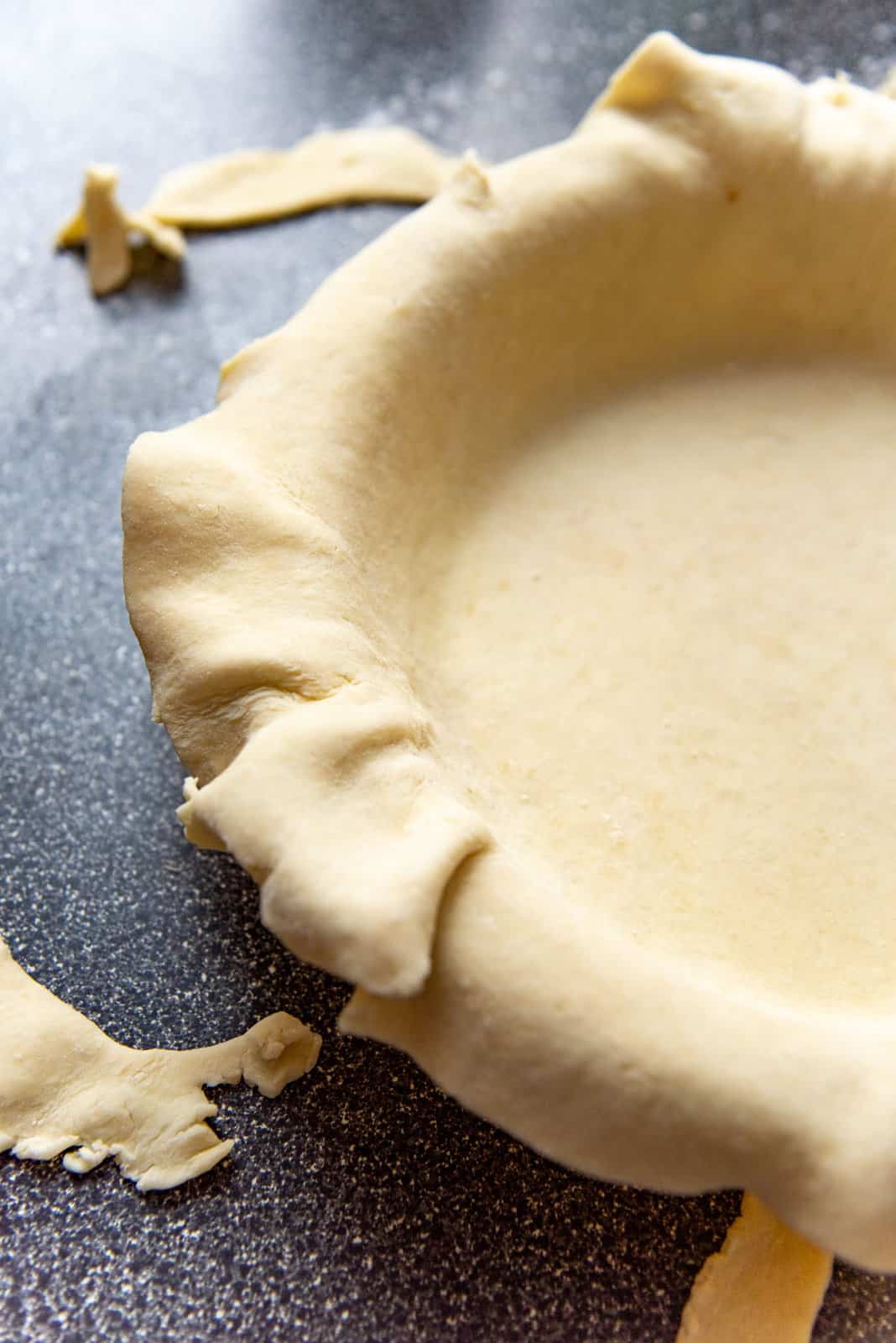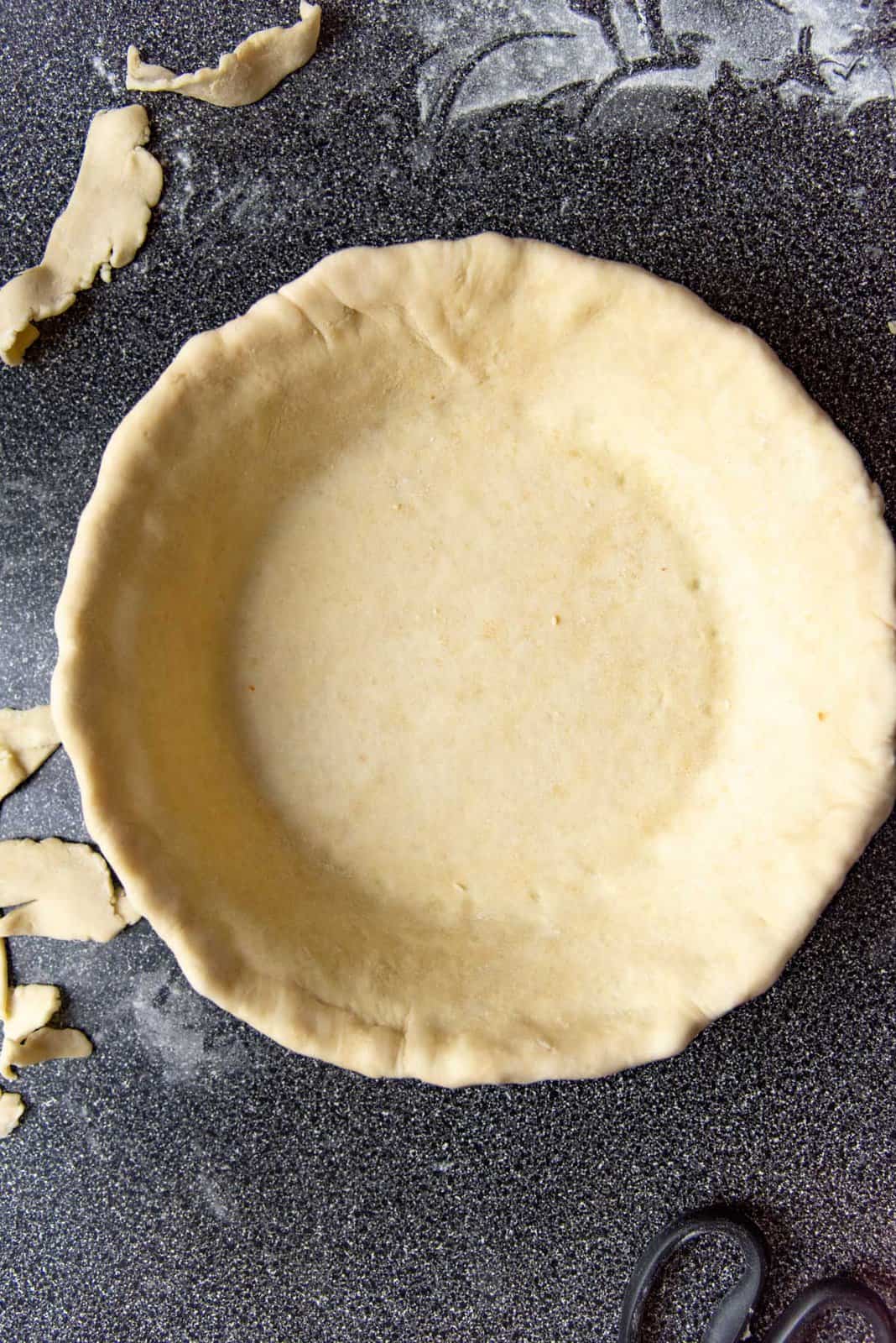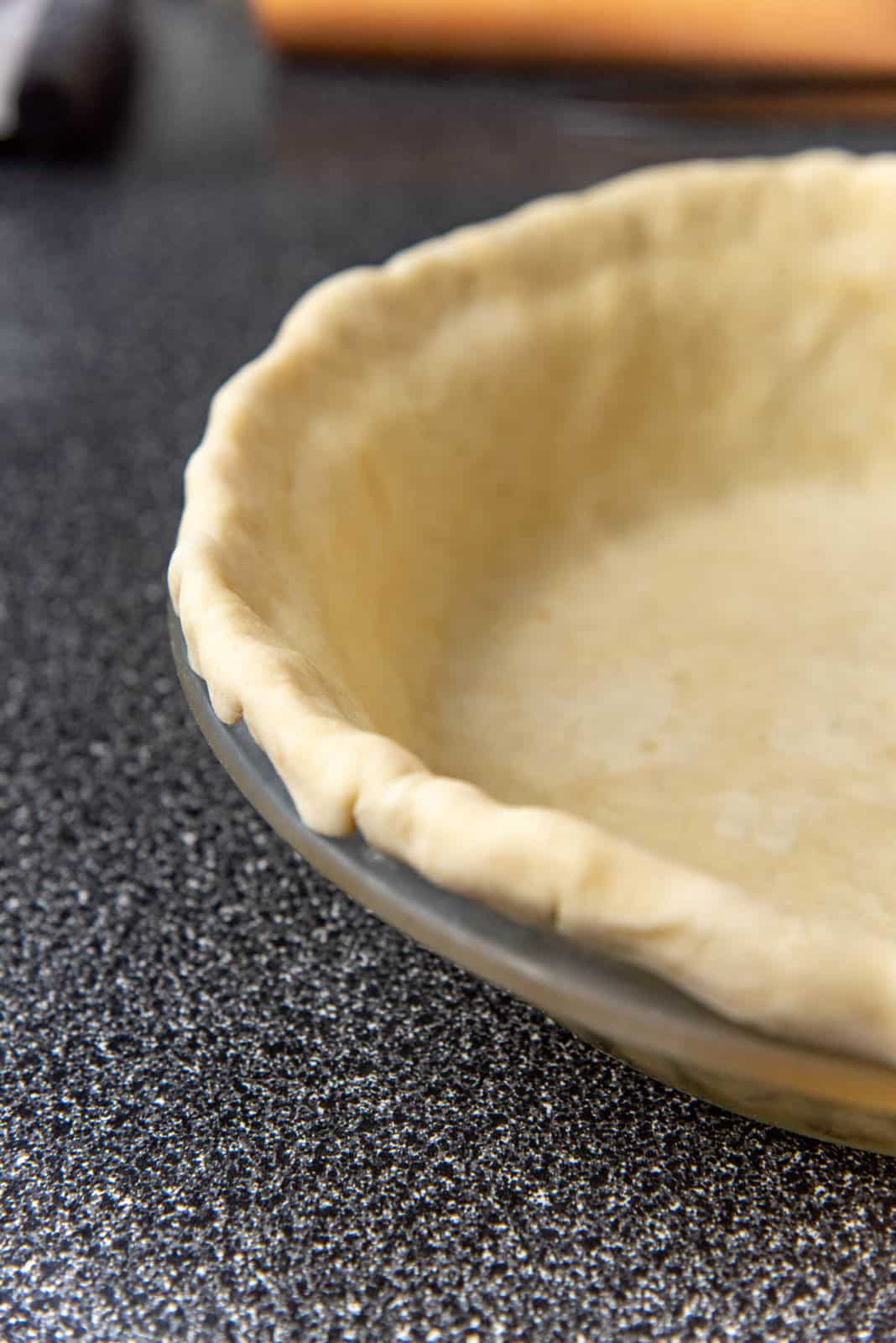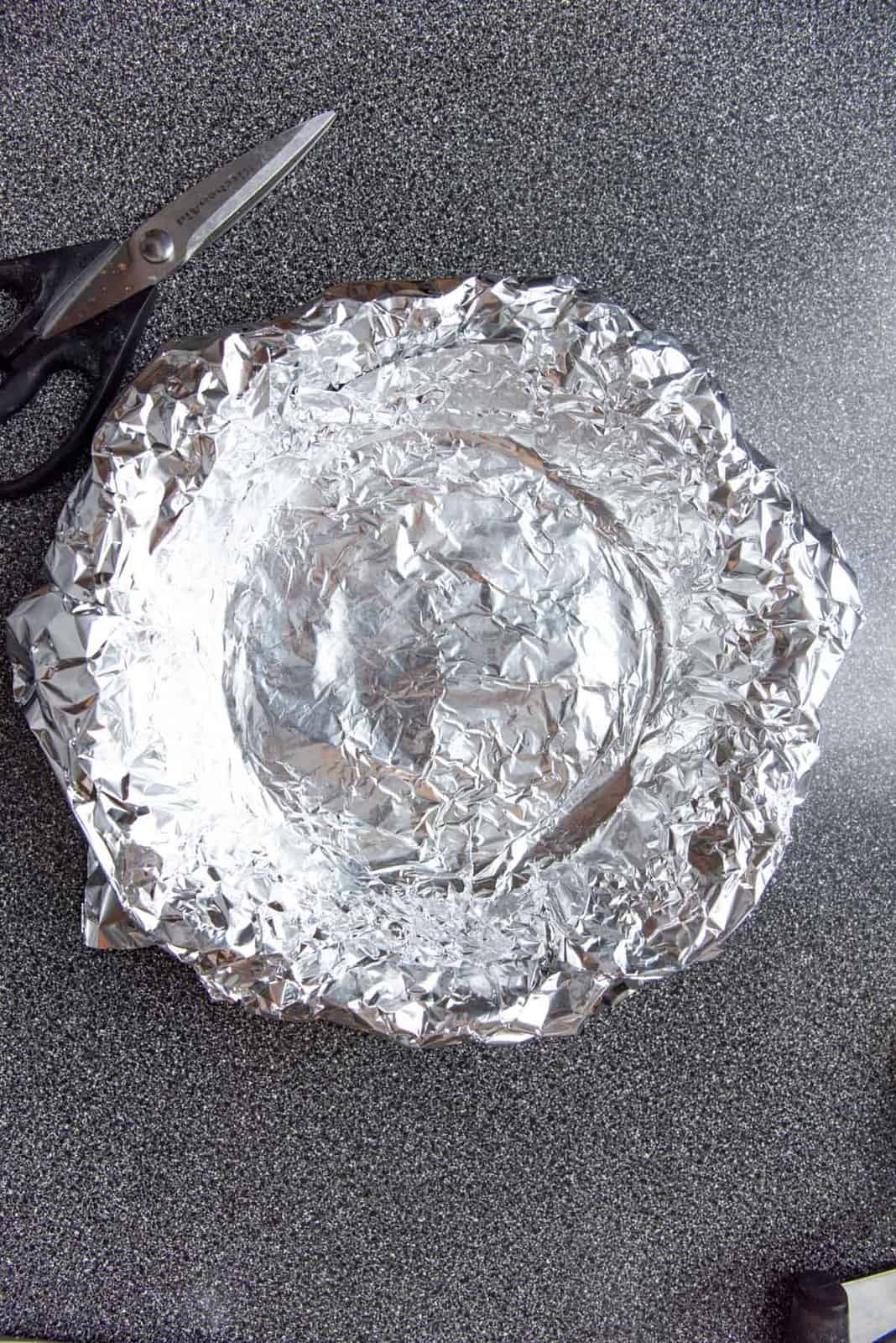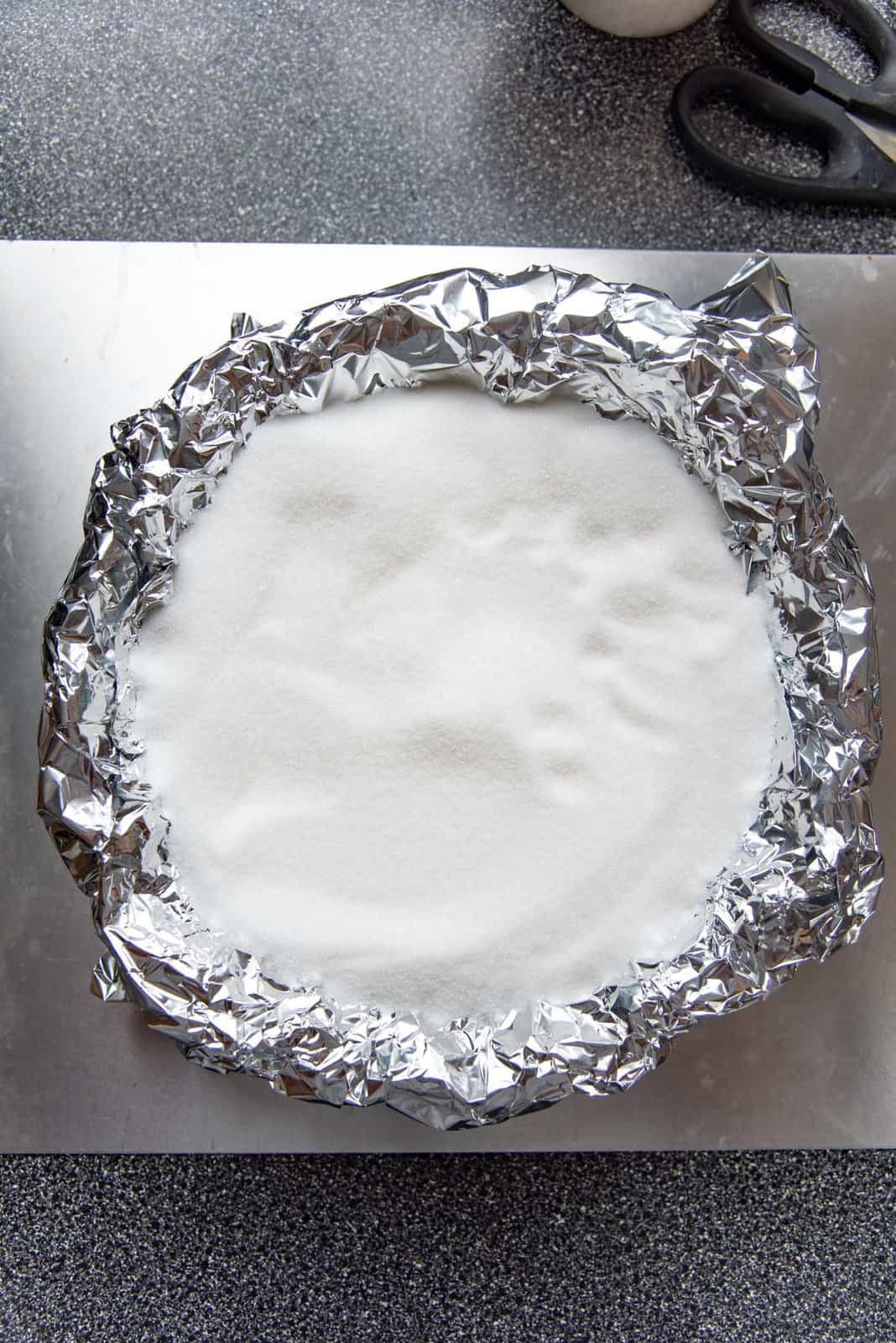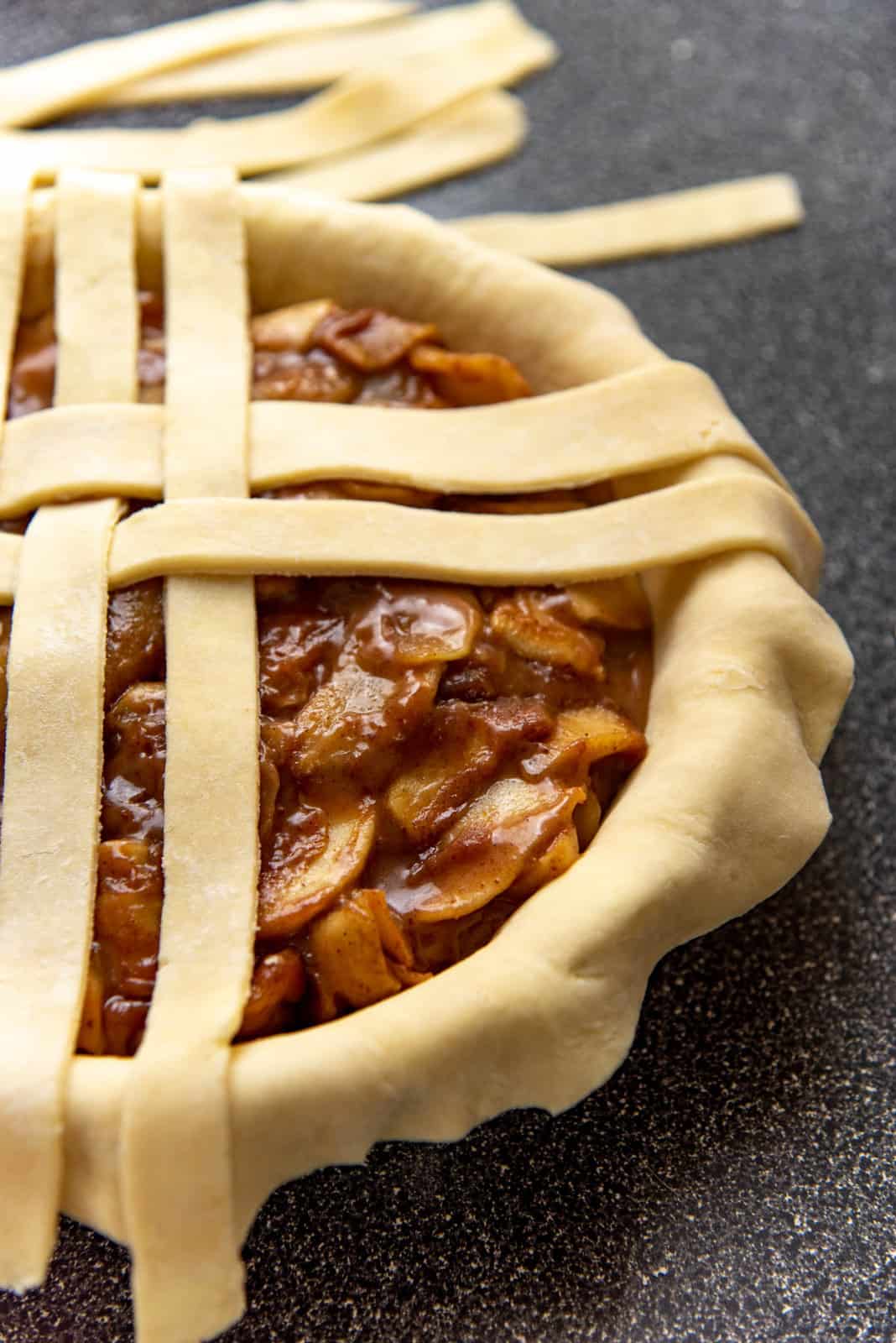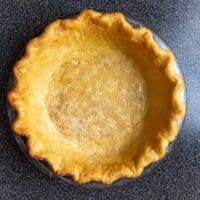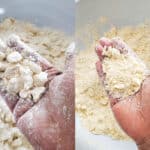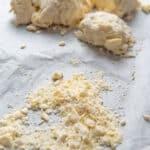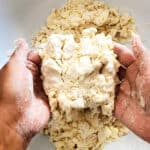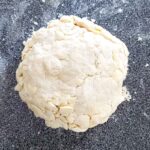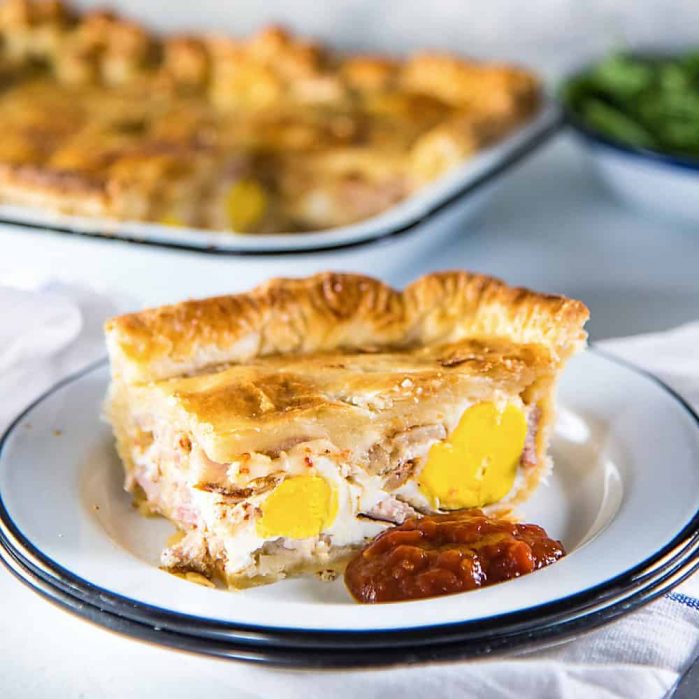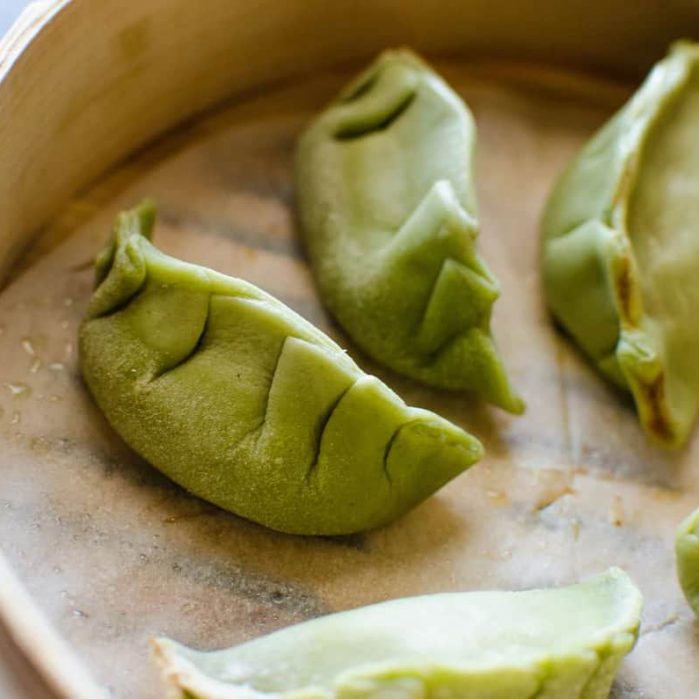But not to worry! This tutorial on how to make pie crusts is written just for you! Here I break down every step of making pie dough, and explain the basics of making pie in detail. Flaky pie crusts – perfect for fruit pies, and even for topping savory pies (such as meat pies). Mealy pie crusts – used for custard pies (such as pumpkin pies), and also as the bottom for meat pies. This is similar to shortcrust pastry as well.
The secret to making very tender pie crust
There is only one major factor that needs to be highlighted when it comes to making perfect pie crust. The secret to a very tender pie crust is to have very little gluten develop in the flour. Less gluten = more tender. Every tip for making pie crusts will contribute to making sure you don’t overwork and develop gluten in your dough. If you are a beginner, I highly recommend using your hands. That extra time you spend handling the dough will help you understand pie dough that much better. When I was first started learning how to make pie crusts, I found that I added too much water whenever I used the food processor.
Flaky pie crust or crumbly pie crust?
I personally love a beautiful flaky pie crust, but a crumbly pie crust is better for a custard-based pie. Each has their purpose in life.
Tips for a flaky pie crust
Keep the butter pieces nice and chilled, and make sure there are larger butter pieces in the pie dough. I like to have large flat pieces of butter throughout the dough. The pie dough will also be “folded” to create layers.
Tips for a mealy pie crust
Keep the butter nice and chilled. The butter can also be grated, or you can use a food processor, since the butter needs to be smaller to create a coarse breadcrumb texture in the dough.
All purpose flour – Preferably 10-11% protein content. AP flour is more widely available in stores. Cold butter – I use unsalted butter, but you can use salted butter too. If you do so, simply reduce the amount of salt you add. Fat in the butter inhibits gluten development. Do NOT use margarine. Ice cold water – Cold water helps to keep the butter solid. Salt and sugar – Salt is a must. Sugar is optional however.
Optional additions
Iced vodka or iced vinegar – Replacing some of the water with vodka or vinegar also helps to reduce gluten development, since water aids in gluten development. Cut the butter into cubes. About ½ – 1 inch cubes if you prefer a flaky crust, or grate the butter for a mealy crust. After preparing the butter, chill it again, in case it softens. In a large bowl, place the flour, salt and sugar (if using). Mix to combine. Add the butter pieces to the flour, and toss the butter to coat it with the flour. Use your fingers to press the butter pieces and flatten them. It’s OK if some break into smaller pieces. Toss to make sure the butter is still coated well with the flour. If the butter softens during this process, put it back in the freezer for a few minutes for the butter to harden again. For a flaky pie crust – You should end up with a mixture with larger pieces of butter in the flour (about 1 inch flattened pieces), and smaller pieces of butter. For a mealy pie crust – The flour mixture should have some pea-sized butter pieces, along with the rest resembling coarse bread crumbs.
Adding the liquid to the dough
Once the butter is cut into the flour mix, liquid will be added to make a dough. Mix the vodka or vinegar (if using) with about ¼ cup of ice water, and pour it gently over the butter and flour mix. Mix the liquid into the butter and flour mix. This will start to create larger lumps. You can use your fingers OR a fork to do the initial mixing. Eventually you will be using your hands / fingers to mix the dough. Add more water – just enough water so that the dough forms / comes together when squeezed, with some dry spots still visible. This is where many beginners encounter problems. Some add too little water, or, more commonly, too much water. Another technique is to use a spray bottle (filled with ice cold water) to spray enough water on the dry spots. This provides them with just enough moisture that they will stick together when squeezed. The same principle applies when you’re making the dough in a food processor. Squeeze a little of the dough in your palm and it should start to stick together. As you add water to the dough, the clumps of dough have excess moisture, while the dry parts have no moisture. The water in the clumps will help hydrate the drier parts of the dough when squeezed together, and allowed to rest. Use the parchment paper to flatten the stack a little. Cut the dough in half again to make two dough portions. Use drops of water to moisten very dry spots if needed. Shape each portion into a circle and wrap each portion with plastic wrap. This recipe will create enough dough for a standard double crusted pie. If you added too much water, liberally flour the dough disc and wrap it in plastic wrap. It is VERY important to let the dough rest in the fridge for at least 1 hour. This resting period will achieve a few things, as follows.
Relax any gluten that develops in the crust. Help hydrate the dough more evenly (as water will disperse from more hydrated areas to more dry ones). Chill the dough and butter so that it’s easier to manage the dough, and will also help create a flakier crust.
Flour your work surface and lightly dust the dough as well. The dough will be hard because it’s chilled, so you will need to make it a little pliable to roll it out properly. Use your rolling pin to hit the dough firmly a few times. Do this on both sides of the dough disc. Start rolling out the dough. It’s important that the dough doesn’t stick to the counter as your roll it out. So make sure the dough and counter are lightly floured, and move the dough around to prevent sticking. To ensure the dough is evenly rolled out, and to prevent it from sticking,
Roll the dough and turn it a quarter turn and repeat. Make sure to flip the dough over, so you roll it out on both sides.
If any cracks appear, simply press the dough together to reseal the dough, and keep going. If at any point the butter softens and looks like it’s melting, OR if the dough is shrinking as you’re rolling it, place the dough on a baking tray and REFRIGERATE for about 15 – 20 minutes to relax the dough. This is so important, as this will help with the final flakiness as well as prevent the pie crust from shrinking when baking. Roll out the dough until it’s about 3mm in thickness. Some pie crust recipes will give you the diameter, but with this recipe, you want to go by thickness. This pie crust recipe allows for extra wiggle room to compensate for any errors. Standard pie plates are usually between 9 – 10 inches. You can also find shallow pie plates that are just over 1 inch in depth, but I like to use the deep pie plates that are about 2 inches in depth. I only use the shallow pie plate for fillings that are very rich and dense. To transfer the rolled out pie dough into the pie plate, you can either,
Fold the dough into quarters, and transfer it to the plate and gently unfold it, OR Roll the dough on the rolling pin, and then gently unroll the dough from the pin onto the pie dish.
It’s VERY IMPORTANT to remember the following when you’re fitting the dough in the pie plate. DO NOT stretch the dough in the pie dish. Gently lift the dough and lay it on the pie dish, rather than stretching it to fit into the pie dish. Once the dough is laid inside the pie dish, use the back of your finger to gently press the dough into the bottom edge of the pie dish. Cut any excess pie crust dough that is hanging off the pie dish, but make sure to leave about a 1 inch overhang for single crust pies, or a ½ inch overhang for double crusted pies. The overhang should be measured from the edge of the pie plate rim. Some pie recipes recommend a ½ inch overhang, but if you’re a beginner, I would go with at least a 1 inch (or 1.5 inches even) overhang. Roll the overhang under the crust to form a thick border that is flush against the edge of the pie pan. IF the butter is soft, let it harden in the fridge for a few minutes. Finally, you can crimp or flute the edge of the pie crust to form the pie crust edge. A heavier pie crust edge will grip onto the edge of the pie plate better and prevent slipping as well. When the pie crust is ready, refrigerate the pie crust for at least 60 minutes, or 30 minutes in the freezer before baking. This allows for the gluten to relax, and for the butter to become firm again. This will help prevent the pie crust from shrinking AND produce a nice flaky crust as well.
How to blind bake pie crust
Blind baking a crust is the method where you bake the crust with no filling. This method is used for par-baking a pie crust, as well as for a fully baked crust with no filling. For this method, you require something to weigh down the crust while it bakes. This helps the crust keep its shape as it bakes and “sets”. Otherwise, the crust will lift off of the pie plate as it bakes. There are many ways to weigh down the pie crust. You will need a piece of parchment paper or non-stick aluminum to line the pie crust first, and then fill it. You can buy ceramic pie weights, but they can be pricey.
Other cheaper options
White sugar – As a bonus, you will end up with sugar that also toasts in the oven! This sugar can be used for baking without a problem. But do keep in mind that this sugar will get some butter in it, so it will NOT be suitable to make meringues. Uncooked rice Dried beans
My favorite options
Of all these options, I love using parchment paper or foil, filled with white sugar. But you will find me using pie weights as well sometimes. This classic method is (relatively) fast, but it took me a VERY long time to get consistent results with this method. You have to ensure that the pie crust is vented properly to prevent the dough from collapsing along the side of the pie plate. The classic method is as follows (a short summary)
Preheat the oven to 425 F / 218 C for at least 30 minutes, with a baking sheet or pizza stone in the oven. Prick the pie crust with a fork, and then line the pie crust with parchment paper or foil. Place pie weights inside the crust. Bake the pie crust in the lower third of the oven, on top of the pizza stone or baking sheet. Bake for 20 minutes. Remove the pie weights, and reduce the oven temperature to 375 F / 190 C. Prick the pie crust with a fork again and return the pie crust to the oven to bake. Par baked crust – bake for another 5 – 10 minutes. Fully blind baked crust – bake for another 20 minutes until the crust is golden in color all over.
Instead of baking the pie crust at two different temperatures, the pie crust is baked for a longer time at a lower, consistent temperature. This technique is what is recommended by Stella Parks as well. Preheat the oven at 350 F / 180 C (conventional oven). Place the oven rack in the lower third of the oven. For best results, place a pizza stone OR a baking tray in the oven and let it preheat for at least 30 minutes before baking the pie. This will help with baking the bottom of the pie crust. When you’re ready to blind bake, prick the bottom of the pie crust with a fork. Take a piece of parchment paper or foil and crumple it into a ball. Then unfold this, and place it on top of the chilled pie crust. A crumpled paper or foil will mold to the shape of the pie crust and fit inside the pie crust edges easily. Fill the pie crust with the weights, making sure they come at least ¾ of the way up, but preferably all the way up. A common mistake beginners will make is to only fill the bottom, which can result in the sides of the crust slipping down and shrinking. Having the weights come all the way up the pie crust will keep the sides and bottom intact and in place. My recommendation is to start with either rice or sugar as the weight. Make sure that the foil or parchment paper extends over the crust, so that it shields the crust naturally, and prevents the crust from browning too much and too early. Place the pie plate in the oven, on top of the pizza stone or baking tray, and bake for 60 – 65 minutes. After 60 minutes, the crust should start to lightly brown. Take the pie crust out of the oven, and very carefully remove the parchment paper / foil ALONG WITH THE WEIGHTS. Do this step very carefully, so that you remove all of the sugar / rice / pie weights. Otherwise, you’ll end up with a mess. Keep an empty bowl next to you, so you can immediately transfer the parchment paper / foil to it. I like to prick the crust with a fork a few times again, and return the pie crust back into the oven. For a par baked crust – Bake for another 5 – 10 minutes, until the bottom of the crust looks matte or dry. It should not brown too much, but a slight golden color is OK. For a fully blind baked crust – Bake for another 15 – 20 minutes until the crust is golden in color all over. To get a beautiful shiny finish, brush an egg wash all over the crust before the final 5 minutes of baking. For both, if the pie crust edges start to caramelize too much, you can use a foil to cover the edges, or you can also purchase silicone pie crust shields. I’ve never needed to do this in my experience, however.
Tips for a double crusted pie (or filled pie)
For pies that will be baked with a top crust, both the bottom and top crusts are not pre-baked. This makes it easier to stick the dough together. You can either use one whole piece of dough as the top crust, or use a pastry cutter or knife to cut shapes or ribbons to create a lattice top or other decorations. If you use a full top crust, make sure to cut holes or shapes for ventilation. The biggest challenge for baking pies that already have a filling, is how to ensure that the bottom also cooks properly without getting soggy or remaining raw.
Foolproof way to perfectly bake a double crusted pie or a pie with filling.
Bake the pie in a preheated oven, on top of a baking stone or tray. Make sure that the pie plate is at the bottom third of the oven, so it’s closer to the main heating element of your oven. Bake the pie at 425 F / 218 C for 10 minutes, and then at 375 F / 190 C for 50 – 60 minutes for that perfect golden crust on the top AND the bottom!
Specialized equipment that will be helpful for making pie crusts (but not all are essential).
Parchment paper or non-stick foil. Pie weights (sugar works very well too – just remember that the sugar CAN get some melted butter in it.) Spray bottle – to spray water to get the right dough consistency. Pizza stone or metal baking tray. Silicone pie crust shields (you can also use shaped foil).
